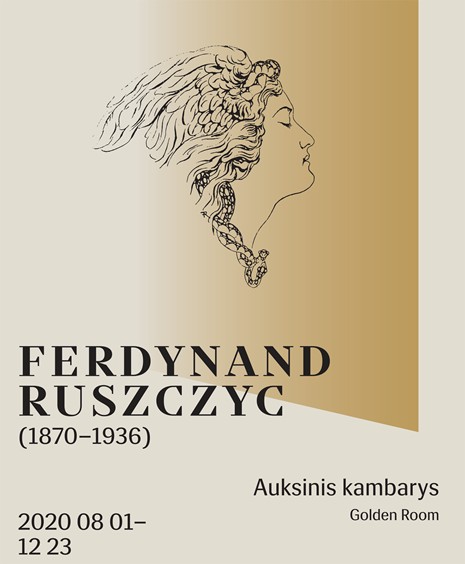Ferdynand Ruszczyc
Golden Room
Ferdynand Ruszczyc (1870-1936) during his time of residence in Vilnius created a pastel with an intriguing title The Golden Room (1913), in which he depicted the interior of the apartment he rented in Užupio street no. 24. In the pastel picture, the shapes of the objects are drawn as if through a mist, not sharply defined, while through the windows an all-overwhelming light is flooding in. For the 150th anniversary of the artist’s birth this year an idea was brought forward, to recreate the Ferdynand Ruszczyc’s Golden Room as a short-term intervention in the permanent exposition at the National Gallery of Art. Therefore, the space is dedicated to the artist’s Vilniusian experiences, where the famous landscape paintings of the artist are replaced with artworks related to Vilnius and documents – from a card addressed to Tadeusz Wróblewski, posters for charity events or book design samples to gilded Vilnius University insignia and images of the fragile royal remains. In the imaginary Golden Room Ruszczyc’s modern European experience is intertwined with his self-awareness as a nobleman, with love for the city and conflicted patriotism.
Vilnius always had a special meaning for Ruszczyc. The artist interpreted the city as the guardian of the historic past, as a living organism, which has “a beating heart, dreams and a reality, visions and sensibility, a semblance and a reflection.” Ruszczyc settled in Vilnius at the end of 1908 and lived here permanently until 1934, when due to illness he was forced to withdraw to his ancestral Bogdanov mansion (in present-day Belarus). This creative period, encompassing the final years of the Tsarist regime in Lithuania, WWI and the rule of the Polish Republic in the Vilnius region, was marked with complex political events, constant conflicts and battles for Vilnius, as well as perpetual collisions of the city’s identity that was repeatedly recreated. The artist knew Vilnius well since his childhood, and he settled here at the peak of his career – after his studies in Saint Petersburg, he lived in Warsaw and Krakow, where with his paintings and activities he earned international recognition. During his residence in Vilnius, Ruszczyc no longer painted, but rather blossomed as a wonderful graphic designer and scenography expert, event organiser, Vilniusian genius loci (spirit of the place) creator, and member of many cultural associations. In 1919, when Vilnius became a Polish city, and the Vilnius University, renamed as the Stephen Báthory University, was opened once more, Ruszczyc took up academic activities. He invested great effort, for the establishment of artistic disciplines in the university’s curriculum. Until 1932 he alternately held the positions of dean and vice-dean of the Faculty of Fine Arts, remained as a member of the senate the whole time, and created the attributes of the university.
Curator: Algė Andriulytė
Architect: Mindaugas Reklaitis
Organisers: The Lithuanian National Museum of Art, National Gallery of Art
Partners: Lithuanian Central State Archives, National Museum of Lithuania, Lithuanian Theatre, Music and Cinema Museum, The Wroblewski Library of the Lithuanian Academy of Sciences, Vilnius University Library, Vilnius University Museum, Vilnius Academy of Arts
The project is financed by Lithuanian Council for Culture
Sponsors: “Exterus”, Fundermax
Gallery name: National Gallery of Art, Vilnius
Address: Konstitucijos ave. 22, Vilnius
Opening hours: Tue, Fri-Sun 11:00 - 19:00, Thu 12:00 - 20:00
Open: 01.08.2020 - 23.12.2020







